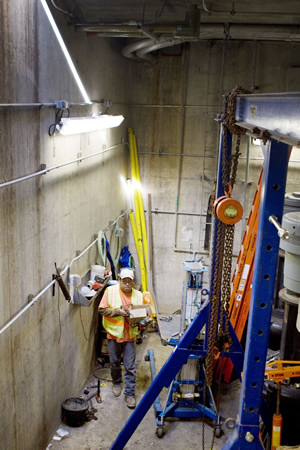The City Council endorsed a 10-year plan Tuesday for capital improvements to the city-run sewer system, funded by rate increases of up to 4.75 percent annually over the next 10 years and a $10 million loan. A jump in fees, which now average about $48 a month, could take effect as early as June.

Staff identified critical projects that carry a collective price tag of about $35 million, which includes $19.2 million for city pipes and lift stations, and $15.5 million for the city’s share of treatment plant upgrades.
Despite repairs that ran to $28 million over the past decade, Water Quality Director David Shissler said there’s more work to do in the decade ahead. Staff also proposes establishing a $2 million reserve fund to prevent the costs of sewer emergencies from impacting other city projects. Unanticipated sewer repairs of $3.7 million forced the deferral of budgeted work in other departments over the past seven years.
Mayor Bob Whalen lauded staff for initiating a reserve, but suggested that a $2 million rainy day fund was still subpar. “We are not fully where we need to be,” he said.
In the meantime, the Council approved a plan to partially fund the improvements over the next decade by borrowing $10 million from the California Infrastructure Bank, or I-Bank, which offers a 3.5 percent interest rate and allows the funds to be drawn as needed. The city secured a similar $7 million I-Bank loan for sewer projects in 2004. It has an outstanding balance of $3.9 million and should be paid off in August 2023.
When residents between roughly Nyes Place and the northern city limits flush their toilets, their sewage travels through a network of 90 miles of pipes assisted by 25 lift stations and empties into a main transmission pipeline known as the North Coast Interceptor. That pipeline feeds into the coastal treatment plant in Aliso Canyon that is jointly owned by the city and the South Orange County Wastewater Authority (SOCWA), which operates it. The South Coast Water District provides sewer service to residents south of Nyes Place.
City customers pay for sewer service, maintenance and treatment through an annual fee added to their property tax bills.
For the bulk of the funding, the Council approved annual fee hikes that could amount to a 23 percent increase by the end of five years, Shissler calculated at the request of Council member Toni Iseman.
Even so, property owners have a state-mandated option to protest rate increases, and if more than 50 percent of Laguna’s roughly 8,538 property owners oppose the measure, the city can’t raise rates.
Staff broke down the $19.2 million worth of improvement projects: replacing two miles of pipeline, $3.1 million; rehabilitating lift stations, $8.5 million; relocating the NCI from Aliso Creek to protect the pipes from flood damage and the creek from sewer spills, $7.6 million. For the latter, the city will save $1 million by collaborating with South Coast Water District since they need to replace a sewer main in the same area and the pipes can share a trench, said Shissler.
At the same time, the city must anticipate contributing $15.5 million over the next decade as its share of upgrade costs for the 30-year-old SOCWA treatment plant. The upgrades, which include improvements to the Aliso Creek ocean outfall, total $62 million, according to the staff report.
The Council also approved spending $80,000 to install a new odor control system at the Bluebird and Laguna SOCWA lift stations. Anyone who has experienced the unsavory smells that periodically emanate from these stations, at the Glenneyre dip and the farmers’ market, respectively, might be surprised to learn that water conservation is partly the culprit. A 25 percent reduction in water consumption has meant longer collection times at the lift stations and an increased concentration of sewage.
The last sewer user rate increase was in 2012 when the city imposed a 3.5 percent hike for three years, ending in 2015. User charges for single family residences in Laguna are “slightly above average” compared to neighboring coastal districts, the staff report notes, though rates for commercial users, who make up only about 4 percent of total users, are more competitive. Laguna’s higher rates stem from the costs of maintaining a sewer system in challenging topography. Indeed, Laguna requires 25 lift stations to transport the waste of 18,000 residents, the most lift stations per capita of any agency in the state that they know of, said Shissler.
Property owners can expect to see notices before the end of the month explaining the proposed fee hike and their right to a protest vote, followed by a public workshop on May 14. The protests must be submitted by June 10. If less than half of the property owners oppose the increases, the Council can mandate the rate increases and begin to pursue the loan by mid-June.





[…] a $10 million loan. A rate increase in 2020 would be in addition to the current 4.75 percent annual increase, where home owners in town pay $609 a year and businesses $599, according to the city website. The […]